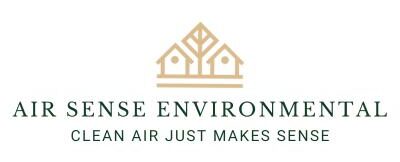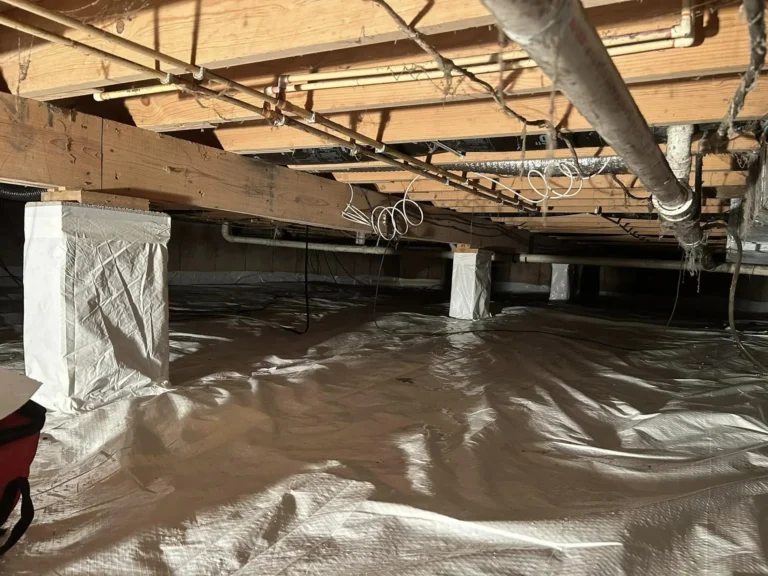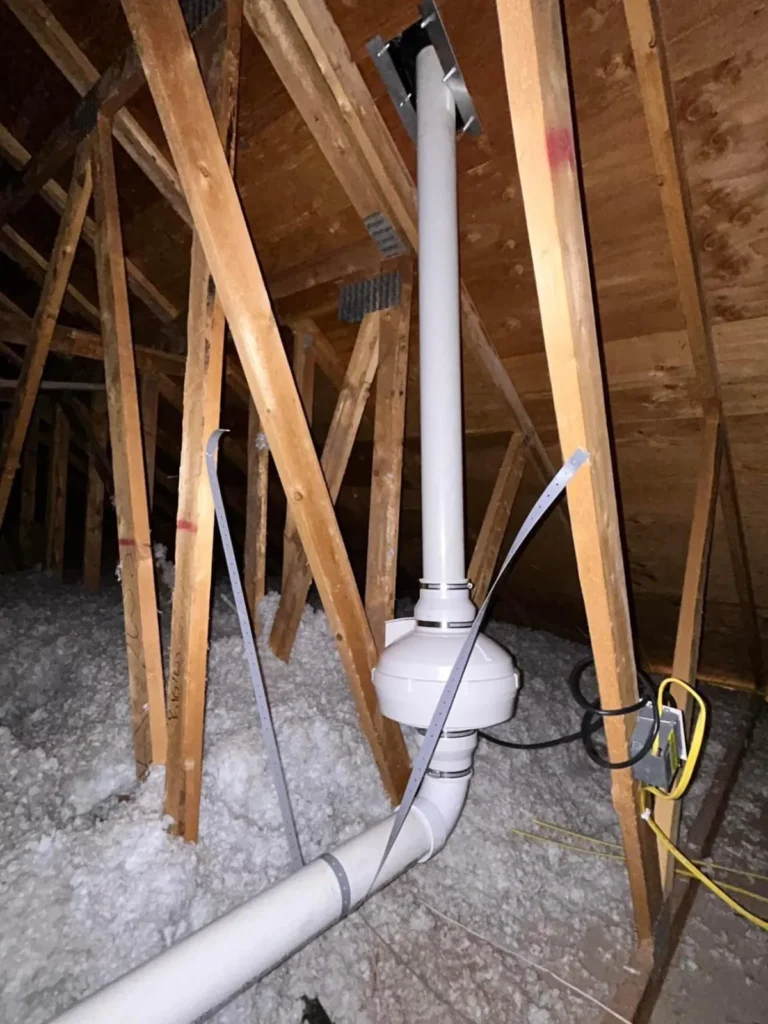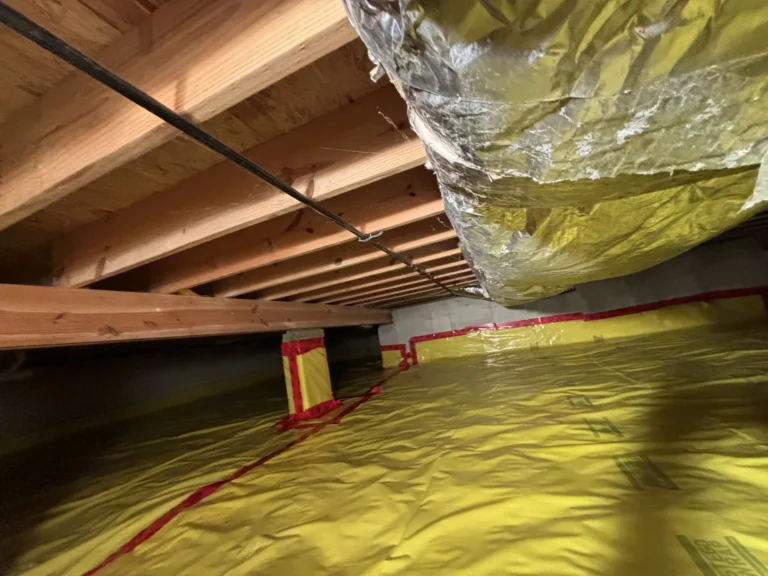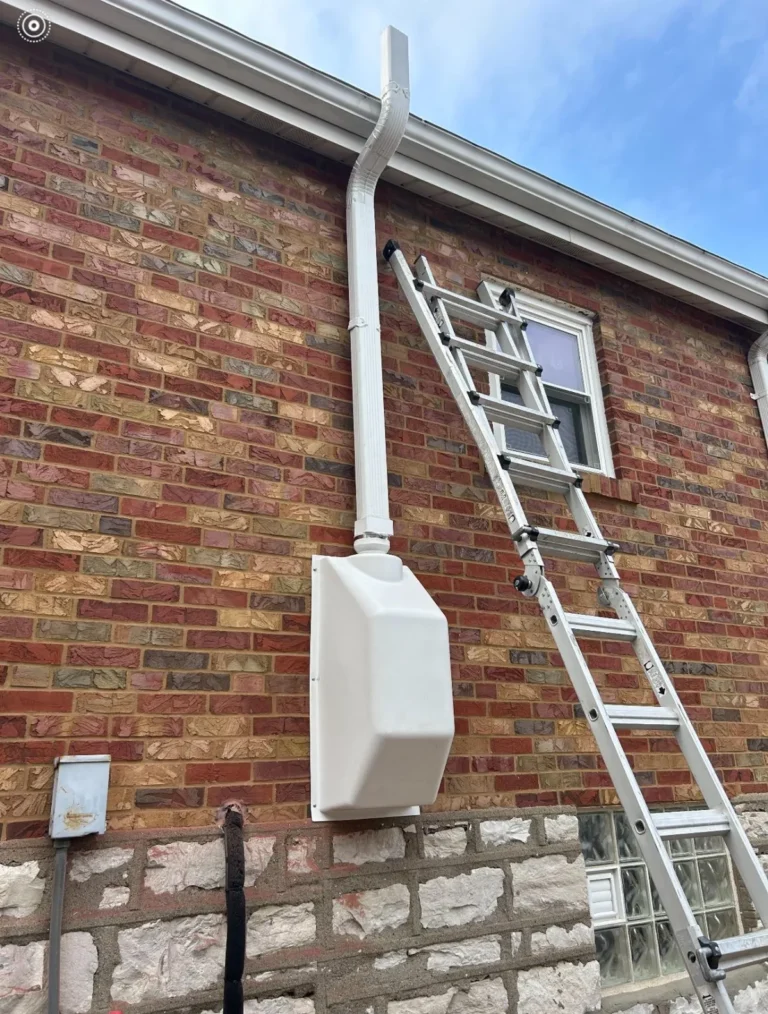Are you truly breathing clean air while you sleep? Probably not—unless you’ve tested and improved your indoor air quality (IAQ).
Compared to outdoor air, indoor air is frequently more polluted, and pollutants can interfere with sleep and negatively impact your health. Not only does indoor air quality affect your health, but it also affects how well you sleep. At Air Sense Environmental, we recognize the connection between indoor air quality and overall well-being, emphasizing the need for air quality testing in St. Louis and surrounding regions to make sure that your living space supports a healthy sleep environment.
Research shows that poor indoor air quality can contribute to various health issues, including respiratory problems, allergies, and sleep disturbances. By engaging with professional services like those offered by Air Sense Environmental, you can create a healthier atmosphere that promotes better sleep, helping you wake up refreshed and ready for the day.
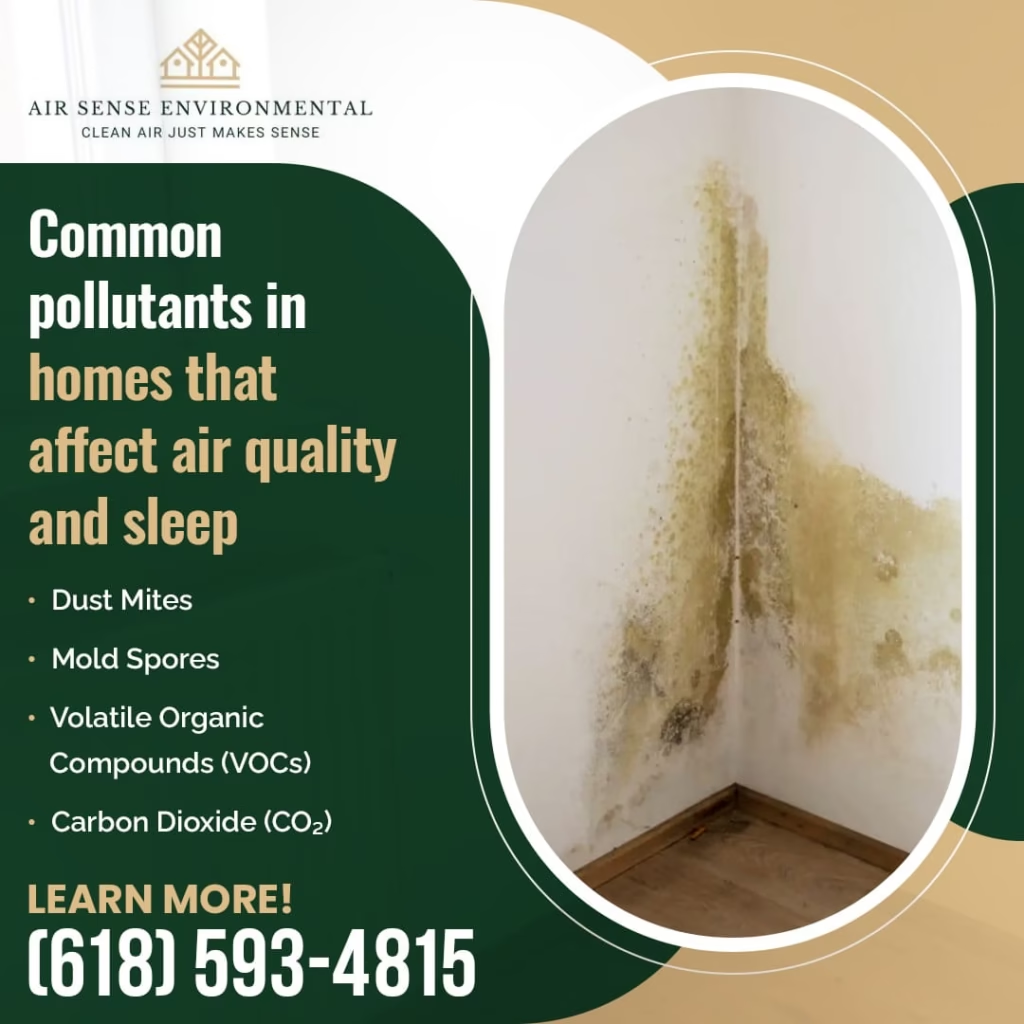
Indoor Air Quality and Its Effects on Sleep
How does indoor air quality affect your sleep? Poor air quality disrupts sleep and affects nighttime recovery.
Pollutants such as dust, mold spores, and high humidity levels irritate the respiratory system and disrupt the body’s natural sleep cycles. Indoor air quality (IAQ) is shaped by factors like temperature, moisture, and airborne contaminants—all of which influence how well you sleep. Maintaining clean, balanced air is essential for deep, restorative rest.
Common Indoor Air Pollutants
What are the most common indoor air pollutants that can disrupt sleep? Dust mites, mold spores, volatile organic compounds (VOC), and excess carbon dioxide (CO₂) are the top culprits behind poor sleep.
The invisible irritants linger in your bedroom air, triggering allergies, congestion, and restlessness. If you’ve ever found yourself tossing and turning, wondering why a good night’s sleep seems so elusive, it might be time to take a closer look at your indoor air quality. These common culprits can not only disrupt your slumber but also impact your overall health, making it essential to identify and address them. By knowing the nature of these pollutants, you can take proactive steps to create a more restful and rejuvenating sleep environment. Let’s explore more about each of these sleep-stealing offenders!
Dust Mites
Dust mites are tiny organisms that flourish in upholstery, carpets, and beds. They may grow rapidly in warm, humid environments and feed on organic materials, such as dead skin cells expelled by people and dogs. Itchy eyes, coughing, and sneezing are all allergic symptoms brought on by dust mites that can disrupt restful sleep. According to research, up to 20 million Americans suffer from dust mite allergies. They can worsen asthma symptoms in your bedroom, resulting in restless nights and poorer quality sleep. Their effects can be lessened by controlling humidity and covering mattresses and pillows with dust mite-proof materials.
Mold Spores
Mold may be extremely harmful to one’s health and grows best in moist conditions. It emits spores into the atmosphere, which may cause allergic reactions and respiratory problems. Inhaling mold spores can cause symptoms like throat irritation, congestion in the nose, and coughing, all of which can interfere with sleep. Studies indicate that mold exposure is associated with more respiratory issues, particularly in youngsters and people with weakened immune systems. To stop mold from growing, you must keep your house dry and well-ventilated. In order to maintain a healthy indoor environment, mold must be remedied as soon as it is discovered.
Volatile Organic Compounds (VOCs)
Paints, adhesives, cleaning supplies, and personal care items are just a few of the household items that contain volatile organic compounds (VOCs). These substances contribute to indoor air pollution and can evaporate at room temperature. Dizziness, headaches, and lung irritation are among the symptoms that can arise from VOC exposure, making it challenging to get a good night’s sleep. Using low-VOC products and ensuring proper ventilation when using such substances can reduce their impact on indoor air quality.
Carbon Dioxide
Elevated levels of carbon dioxide (CO2) are a common concern in poorly ventilated spaces, particularly bedrooms during the night when closed windows can limit outside air intake. High CO2 levels can lead to drowsiness, headaches, and decreased cognitive function, negatively impacting sleep quality. Ensuring adequate ventilation in your home, especially in sleeping areas, can help keep CO2 levels in check, supporting a better sleep environment.
Both ASHRAE (American Society of Heating, Refrigeration, and Air Conditioning Engineers) and Health Canada recommend maintaining indoor CO₂ levels below 1,000 ppm to ensure healthy indoor air quality, comfort, and proper ventilation in residential and commercial buildings.
By recognizing and addressing these common indoor air pollutants, you can improve the quality of your sleep and overall well-being. Regular air quality testing and monitoring can help identify potential sources of pollution so you can take the necessary steps toward creating a healthier home.
The Importance of Indoor Air Quality Testing
Why is indoor air quality testing important for better sleep? It helps detect hidden pollutants that may be disrupting your rest.
Monitoring indoor air quality is key to evaluating the environment you’re sleeping in. Professional air quality testing reveals issues like allergens, mold, or chemical pollutants—allowing you to fix them before they impact your health and sleep quality. It will enable you to take actionable steps to mitigate these issues before they affect your sleep quality.
Benefits of Air Quality Testing
What are the key benefits of getting your indoor air quality tested? It protects your health, guides home improvements, and provides peace and comfort.
By comprehending exactly what’s in the air you breathe, you can take meaningful steps to improve your home environment and sleep quality.
- Health Protection: Testing uncovers hidden pollutants—like mold spores, VOCs, and allergens—that can aggravate asthma, trigger allergies, and affect sleep. Identifying these early allows for timely mitigation and supports long-term health.
- Informed Decisions: With data from your air quality report, you can make smarter decisions about upgrades such as filtration systems, ventilation improvements, or mold remediation—ensuring your efforts are targeted and effective.
- Peace and Ease: There’s comfort in knowing your air is safe. Whether you’re concerned about your children’s respiratory health or simply want better sleep, testing provides clarity and reassurance that you’re creating a healthier home environment.
Improve Indoor Air Quality for Better Sleep
How to Improve Indoor Air Quality for Better Sleep? Improving indoor air quality is a continuous effort that involves maintaining a clean, well-ventilated, and low-pollutant environment—essential steps for creating a healthier, more restful sleeping space.
Here are some effective strategies you can implement:
1. Ventilation
Reducing indoor pollutants and preserving a healthy living space depends on proper ventilation. The concentration of dangerous chemicals in your house can be lowered by letting fresh air flow. Exhaust fans, which effectively remove moisture, smells, and airborne contaminants, can be used in places like restrooms and kitchens to do this. Furthermore, opening windows when the weather permits let in fresh outdoor air, which enhances airflow and quality even more. In addition to improving indoor air quality, strategic ventilation also helps control temperature, which makes your house more comfortable.
2. Control Humidity
Sustaining appropriate humidity levels between 30% and 50% is essential for inhibiting the formation of mold and warding off dust mites. Mold can grow easily in an atmosphere with too much humidity, which poses major health hazards. Dehumidifiers are a useful tool for removing excess moisture from the air in damp spaces like bathrooms and basements. Additionally, you may identify problem areas and take preventative action to keep your house dry by routinely checking the humidity levels. You and your family will live in a more pleasant and healthful environment if the proper humidity balance is achieved and maintained.
3. Regular Cleaning
Consistent cleaning is one of the most straightforward ways to keep indoor allergens under control. Regular dusting and vacuuming help reduce the presence of dust, pet dander, and other pollutants in your home. When cleaning, consider using a vacuum cleaner equipped with high-efficiency particulate air (HEPA) filters, which are designed to trap smaller particles, including allergens, effectively. Don’t forget to wash bedding, curtains, and upholstery frequently, as these can all accumulate allergens over time. By making cleaning a regular part of your routine, you promote a healthier living space and contribute to better overall air quality.
4. Air Purifiers
Investing in air purifiers with HEPA filters can substantially enhance the air quality in your home, especially in bedrooms where good air quality is critical for restful sleep. These devices work by capturing and filtering out airborne pollutants, such as dust, pollen, pet hair, and mold spores. Placing an air purifier in frequently used areas can also help to reduce allergens and irritants, leading to a more comfortable environment. Some advanced air purifiers even come with additional features, such as activated carbon filters that can remove odors and volatile organic compounds (VOCs), further improving indoor air quality.
5. Reduce Chemical Exposure
Reducing your exposure to harmful chemicals is a key part of improving indoor air quality. Choose non-toxic or eco-friendly cleaning products that won’t release harsh fumes into your home. Avoid common indoor pollutants like cigarette smoke and scented candles, which can emit particulate matter and volatile organic compounds (VOCs). For a safer alternative, try natural options like essential oil diffusers to add fragrance without harming the air. By making thoughtful choices about the products you use, you help create a healthier, cleaner environment for you and your family.
The Role of Air Sense Environmental in Enhancing Indoor Air Quality
How can Air Sense Environmental help you sleep better at night? By identifying and addressing indoor air pollutants that disrupt sleep, Air Sense Environmental helps you get better sleep.
At Air Sense Environmental, we provide a suite of services dedicated to improving indoor air quality and ensuring that you and your family can enjoy restful nights. Our air quality testing services in St. Louis identify harmful pollutants that may disrupt your health and sleep.
Integrated Testing and Solutions
What solutions does Air Sense Environmental offer to improve indoor air quality? We provide highly professional testing, tailored solutions, and ongoing monitoring to keep your home’s air clean and healthy.
Our experienced team utilizes advanced monitoring technology to assess your indoor air quality accurately. We can pinpoint pollutants such as allergens, mold spores, and volatile organic compounds, empowering you with the information needed to take corrective action. Our solutions include:
- Air Quality Analysis: A complete evaluation of your home’s air quality to identify pollutants and provide tailored solutions.
- Installations of Quality Products: We install high-quality air purifiers and ventilation systems designed to improve air quality and reduce allergens.
- Regular Monitoring Services: Continuous air quality monitoring keeps your indoor environment safe and healthy over time.

Create a Healthier Sleep Environment
What’s the final step to achieving cleaner air and better sleep at home? Partner with professionals like Air Sense Environmental to test, monitor, and improve your indoor air quality.
Clean air isn’t a luxury—it’s a necessity for quality sleep and long-term health. With expert testing and tailored solutions, Air Sense Environmental helps you uncover hidden air quality issues and fix them quickly. Take control of your indoor environment and give your family the restful, healthy nights they deserve.
If you are ready to enhance the air quality in your home and improve your sleep, contact Air Sense Environmental – Radon Mitigation & Testing today. We’re here to help you breathe easier and rest better.
You can reach us at (618) 593-4815 or via email at [email protected].
Together, we can cultivate a sanctuary of clean air for you and your family, leading to healthier lives and more rejuvenating sleep.
